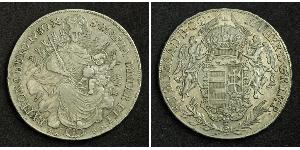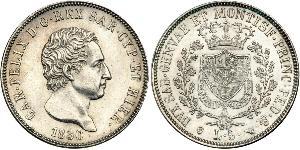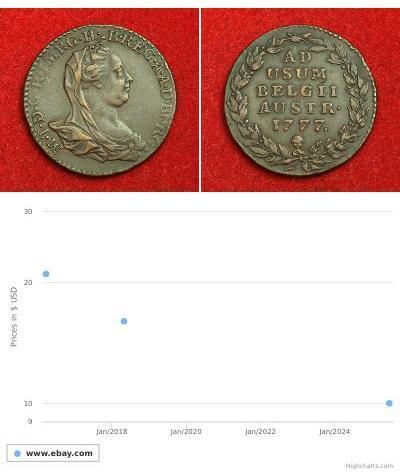(sold for $30.0)
1724, Switzerland, Geneva (Canton). Bronze "Benedict Pictet" Medal by Dassier!
Mint year: 1724 Mint Place: Geneva Medallist: J.A. Dassier Denomination: Medal - Benedict Pictet Reference: Eisler, II, 96, 5; Schweizer Med. 1530. Condition: A nice XF-AU with beautiful choclate patina! Material: Bronze Diameter: 28mm Weight: 9.79gm
Obverse: Draped bust of Benedict Pictet right. Medallist´s signautre (J.D.) at 4 o'clock. Legend: BENEDICT PICTET. / J.D.
Reverse: Inscription in eight lines. Signature of the medallist and date of the issue (1724) in exergue. Legend: PASTEUR ET PROFESSEUR EN THEOLOGIE À GENEVE MEMBRE DES SOCIETÉS ROIALES DE LONDRES ET DE BERLIN NÉ LE 30. MAI 1655. Exergue: J. DASSIER. F. / 1724
Jean Dassier (October 17, 1676 – November 12, 1763) was a Swiss engraver and medallist. Dassier was born in Geneva, and his father was the official Mint Engraver for the Canton of Geneva. In 1703 Dassier married Anne Prevost-Gaudy, and they had two sons. He studied in Paris with Jean Mauger and Joseph Roettiers, and he became an assistant to his father. In 1712 Dassier was admitted as a master in the guild of goldsmiths. In 1720 he succeeded his father as the official engraver for Geneva. He was appointed to the Council of Two Hundred in 1738. Dassier died on November 12, 1763. At his death, his son Antoine took over as the chief engraver of Geneva currency.
Benedict Pictet (1655–1724) was a Swiss Reformed theologian. He was born at Geneva on 30 May 1655. After receiving a university education there, he made an extensive tour of Europe. He then assumed pastoral duties at Geneva, and in 1686 was appointed professor of theology. He died there on 10 June 1724. He sought to revive the old orthodox theology, but was unable to prevent the Genevan Company of Pastors from adopting a new formula of subscription in 1706. Pictet was also known as Christian poet, some of his hymns being included in French hymnals. Other works were Huit sermons sur Vexamen des religions (3d ed., Geneva, 1716; Eng. transl., True and False Religion examined; the Christian Religion defended; and the Protestant Reformation vindicated, Edinburgh, 1797, by Archibald Bruce) and Dialogue entre un catholique et un protestant (1713; Eng. transl., Romanist Conversations, London, 1826 by Henry Huntingford).
From the beginning the bishopric of Geneva was a suffragan of the archbishopric of Vienne. The bishops of Geneva had the status of prince of the Holy Roman Empire since 1154, but had to maintain a long struggle for their independence against the guardians (advocati) of the see, the counts of Geneva and later the counts of the House of Savoy. In 1290 the latter obtained the right of installing the vice-dominus of the diocese, the title of Vidame of Geneva was granted to the counts of the House of Candia under count François de Candie of Chambery-Le-Vieux a Chatellaine of the Savoy, this official exercised minor jurisdiction in the town in the bishop's. In 1387 Bishop Adhémar Fabry granted the town its great charter, the basis of its communal self-government, which every bishop on his accession was expected to confirm. When the line of the counts of Geneva became extinct in 1394, and the House of Savoy came into possession of their territory, assuming after 1416 the title of Duke, the new dynasty sought by every means to bring the city of Geneva under their power, particularly by elevating members of their own family to the episcopal see. The city protected itself by union with the Swiss Federation (German: Eidgenossenschaft), uniting itself in 1526 with Berne and Fribourg.
The Protestant Reformation affected Geneva. While Bern favoured the introduction of the new teaching and demanded liberty of preaching for the Reformers Guillaume Farel and Antoine Froment, Catholic Fribourg renounced in 1511 its allegiance with Geneva. In 1532 the Roman Catholic bishop of the city was obliged to leave his residence, never to return. In 1536, the Genevans declared themselves Protestant and proclaimed their city a republic. The Protestant leader John Calvin was based in Geneva from 1536 to his death in 1564 (save for an exile from 1538 to 1541) and became the spiritual leader of the city. Geneva became a centre of Protestant activity, producing works such as the Genevan Psalter, though there were often tensions between Calvin and the city's civil authorities. Though the city proper remained a Protestant stronghold under St. Francis de Sales, a large part of the historic diocese returned to Catholicism in the early seventeenth century.
During the French Revolution (1789-1799), aristocratic and democratic factions contended for control of Geneva. In 1798, however, France, then under the Directory, annexed Geneva and its surrounding territory.
In 1802 the diocese was united with that of Chambéry. At the Congress of Vienna of 1814-15, the territory of Geneva was extended to cover 15 Savoyard and six French parishes, with more than 16,000 Catholics; at the same time it was admitted to the Swiss Confederation.
Only 1$ shipping for each additional coin purchased!

|
Posted by:
anonymous 2017-06-02 |
5 Lira Italian city-states Silver Charles Felix of Sardinia
group has 18 coins / 16 prices
⇑























